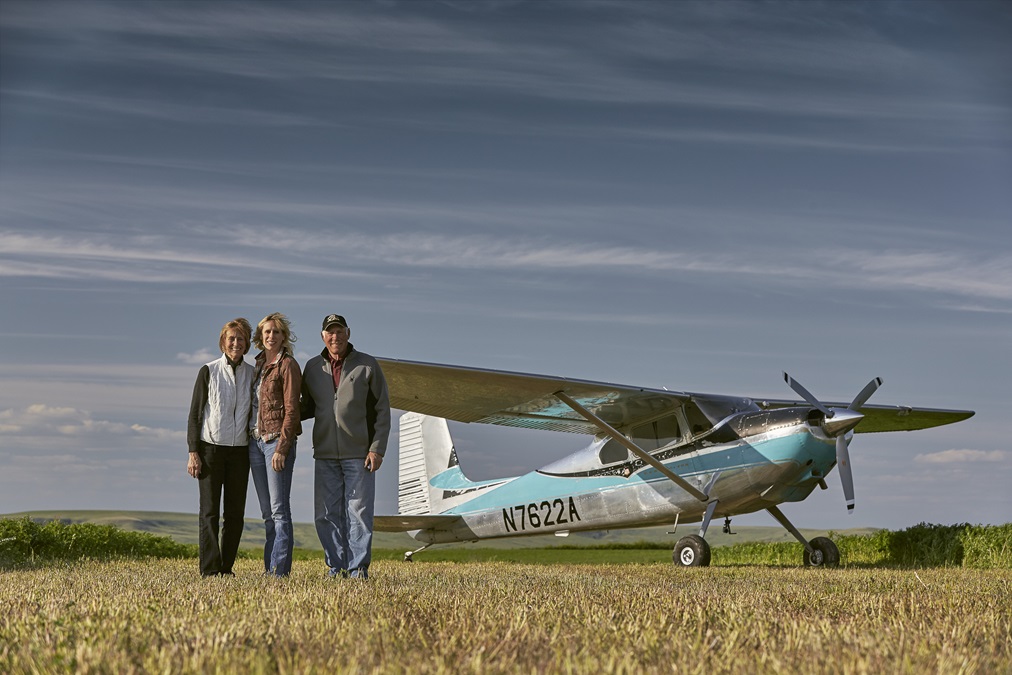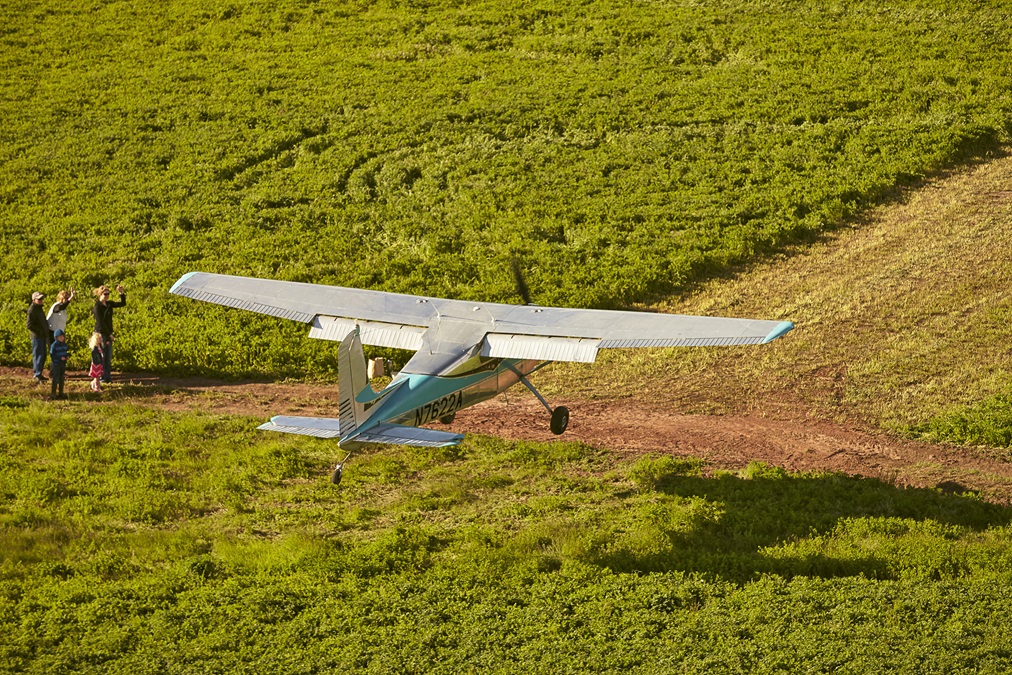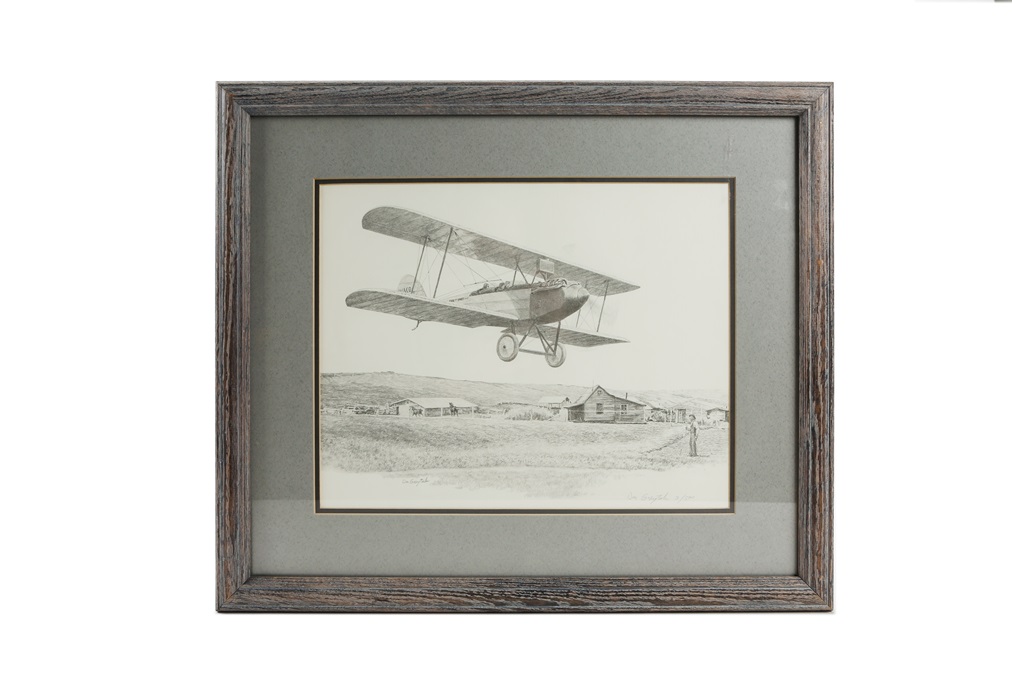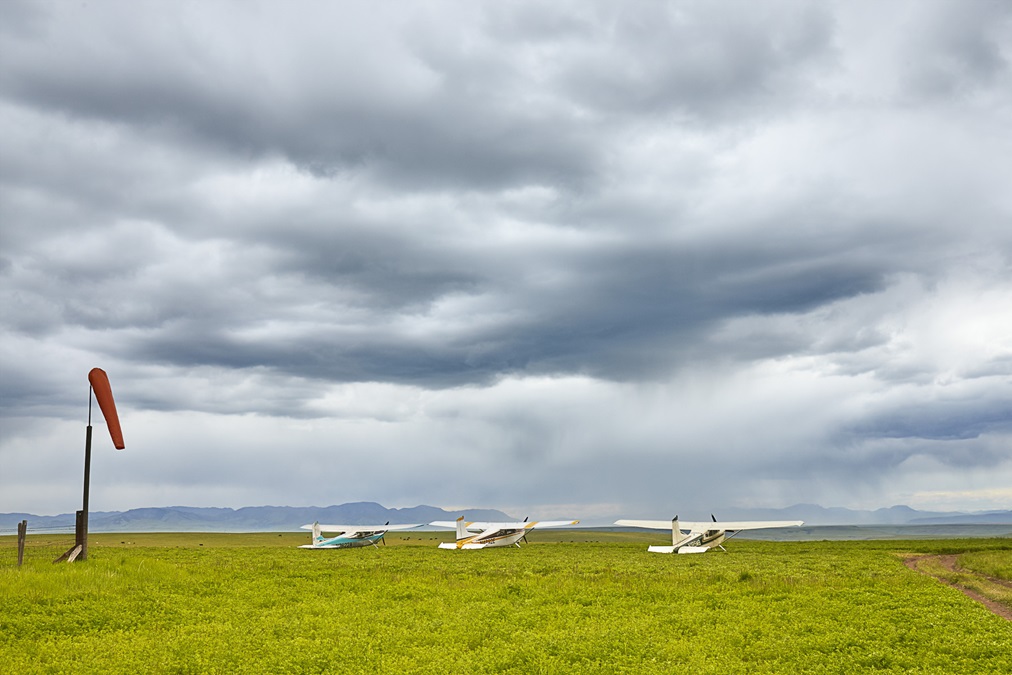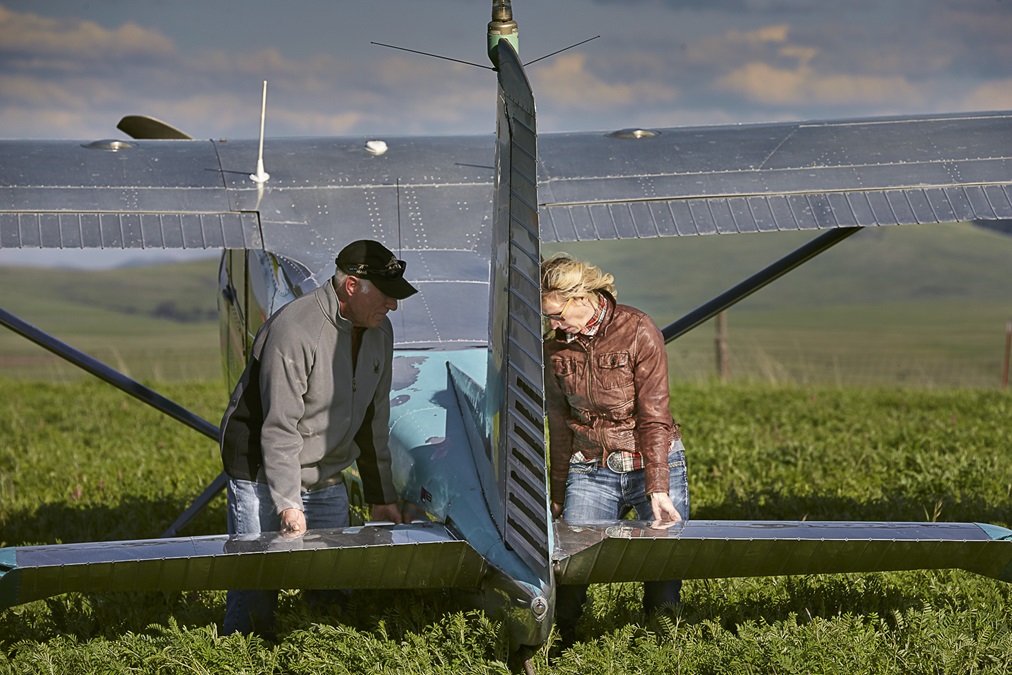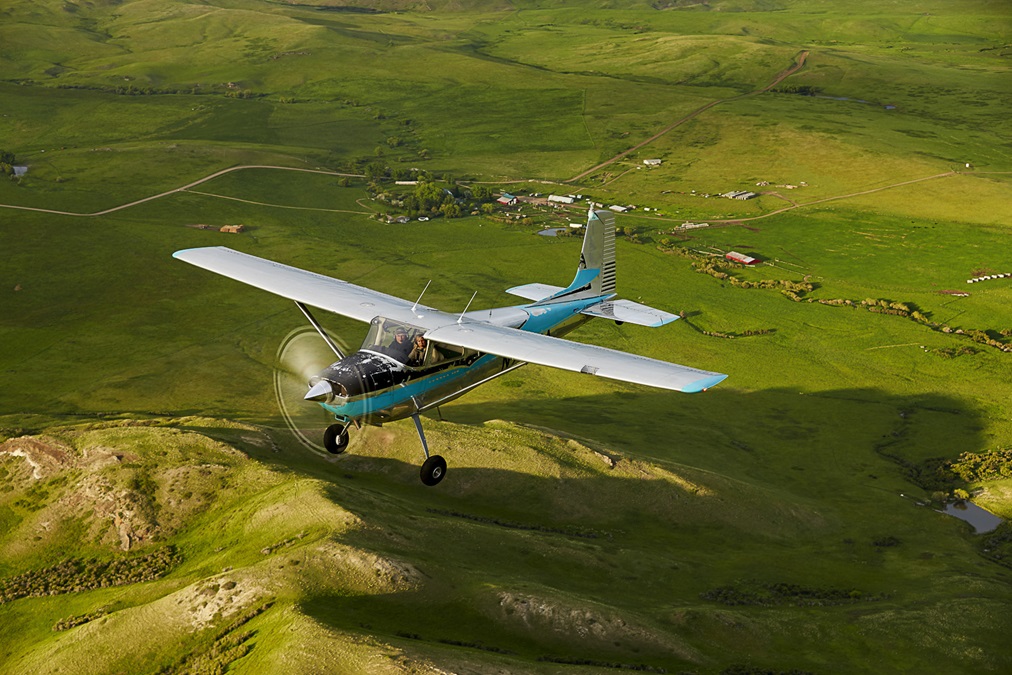A daughter's homecoming
A ranch airstrip fulfills a cowgirl’s dream
A gash in an alfalfa field is identifiable as an airstrip only because of the telltale windsock that, on this cool spring afternoon, sways to a gusty breeze. In the foothills of the Rocky Mountains, cattle rancher Rod Pribyl cut this 30-foot-wide swath at the request of his daughter, Katie, and with a nod to family lore.
In May 1927, Rod’s grandmother Theresa and father Ernie—who was 8 years old at the time—got stuck in the town of Great Falls, Montana, because of a spring deluge that made roads impassable. The pair spent several days at a local hotel but they were running short of cash, and Theresa was needed on the ranch. So they walked to the nearby fairgrounds, found a Waco biplane owned and flown by the only commercial pilot in the region, and hired him to drop them off at the ranch about 20 miles south.
Their reverse negotiation went something like this: The pilot said he’d charge $10 to make the flight. Theresa said she’d pay $15 (the equivalent of $215 today) if he delivered them alive.
The drop-off took place at the crest of the same hayfield where Rod would build an airstrip 89 years later. And throughout his life, Ernie would tell the story of his family’s thrilling introduction to flying. The tale became such a part of family lore that, for Ernie and wife Emma’s fiftieth wedding anniversary, Rod commissioned an artist to draw a pen-and-ink sketch of the ranch landing.
Using old photos, the artist depicted the 1927 touchdown in nearly photographic detail.
“The lean-to house, the period farm equipment, my grandfather’s expression, even the way he’s standing, is totally true to life,” Rod said. “It’s as close as anyone can get to how it must have been on that day and at that moment.”
The framed drawing hangs in the living room of the 100-plus-year-old home where Rod and wife Julie live. And each of the couple’s three daughters owns a copy.
“It’s something we treasure,” said Katie, an AOPA executive and former airline pilot, who keeps her framed print of the drawing on an office wall in Frederick, Maryland. “My grandfather loved telling that story and I loved hearing it. Even though he was so young at the time, he remembered it vividly his entire life. You could tell the story wasn’t embellished because the details never changed.
“I come from a family of ranchers, and none of my relatives had ever been involved in aviation professionally,” she said. “I’ve got to believe that, at some level, that story, and my grandfather’s joyful and frequent retelling of it, helped draw me to flying.”
‘I’m nervous’
From the air, the runway at the Pribyl Ranch looks intimidating. There’s a ditch at the approach end, a downhill grade when landing southwest, and a pronounced dogleg to the right. The ground has been rolled to get rid of ruts and stubble, but it’s no putting green, or even a fairway. Thigh-high crops on either side could overturn any aircraft unfortunate enough to get a wheel in it.
Rod and Julie are on the ground watching and waiting.
A rainy spring has left the ground unusually soft, and Rod wears knee-high rubber boots to keep his feet dry. He says he’s confident the runway is firm enough to support Katie’s Cessna 180 Skywagon—the airplane she bought two years ago for the express purpose of flying here. “The drainage is surprisingly good,” he said. “The runway is the driest place on the ranch.”
Katie has flown about 15 hours over the past two days to get to Montana from the East Coast. The final destination is the strip.
Katie knows every rock-strewn foot of this 8,000-acre ranch. But the strip’s width is less than her Skywagon’s wingspan. The field elevation is about 4,200 feet, and on this day the density altitude is more than 5,000 feet.
Katie makes a wide oval pattern with a two-mile final approach. “I’m giving myself a long final,” she says, her voice tense.
Manual flaps and elevator trim are set and the approach appears stable. But in the cockpit Katie balks. At about 100 feet agl, she applies full power and goes around. Then she makes another left-hand traffic pattern, takes a few deep breaths, and settles in. “I’m nervous,” she says. “I’m really, really nervous.”
‘Buy’ button
Growing up, Katie had always thought she would become a veterinarian. It’s highly technical, involves working closely with people and animals—and, for a ranching family, totally practical.
That changed during an exchange trip to Japan while Katie was in high school, when Ernie’s story met a Boeing 747 at San Francisco International Airport. As she walked to the gate and saw the jet that would carry her across the Pacific, it stirred something in her. On the return trip to Great Falls, she rode the final leg in a turboprop
de Havilland Dash 8. “We were getting rocked by turbulence over the mountains west of Great Falls, and for some reason I absolutely loved it,” she said. “It didn’t bother me at all. When we landed, I knew I wanted to be a pilot.”
Her parents thought their daughter’s aviation infatuation was a passing phase. But Katie sold the small steer herd she had been raising to pay for flying lessons, and she got her private pilot certificate in three months during the summer following her senior year in high school. She went to college at Embry-Riddle Aeronautical University in Prescott, Arizona, and landed a job flying Canadair CRJ200s upon graduation. At 21 years old, she was flying jets to and from some of the world’s busiest airports. As she gained airline seniority, she expected to be able to live in Montana and commute to work.
Katie was flying an airline trip to New York City on September 11, 2001, when ATC put out the unprecedented call for all aircraft to land immediately. She and her crew diverted to Clarksburg, West Virginia, and she completed the trip in a Greyhound bus. In the aftermath of the terrorist attacks, Katie was furloughed along with tens of thousands of other airline employees.
Rather than start over at another carrier, she turned to general aviation by joining the staff at the General Aviation Manufacturers Association and, later, AOPA. “My flying roots are in general aviation,” she said. “That’s where I felt I could make the greatest impact.”
But her second career as an association executive in the Washington, D.C., area was hopelessly at odds with her desire to someday return to her family’s Montana ranch. And she saw no way to reconcile the two callings. Then in late 2014, she bought an airplane she hoped would bridge the gap.
The Cessna 180 had the speed and range to cover long distances, and the capability to operate from unpaved strips at high elevations. A colleague found a 1956 model on eBay that was almost completely original, and Katie pressed the “Buy” button.
She had to learn to fly tailwheel airplanes, and she upgraded the airplane with a three-blade Hartzell prop, new starter, alternator, IFR panel, and a new headliner.
Her dream of flying to the family’s ranch was almost within reach.
Fresh alfalfa
Rod was of two minds regarding a ranch runway. The non-irrigated “dry land” ranch depends on irregular rainfall for crops that feed 500 cattle. Even a modest runway would require giving up needed hay. But Rod was enthusiastic about everything that had to do with flying. During college at Montana State University in the 1960s, he had been recruited to become a U.S. Navy pilot but declined when his father needed help at the ranch, which had been in the family since Montana statehood in 1889.
“I’ve always been fascinated with aviation,” Rod said. “But being a rancher requires sustained effort. And once I committed to that path, I had to give it my all.”
Rod cleared the runway in two passes with a 15-foot swather, and then smoothed the ground with a roller. “My neighbors thought I’d lost my mind when they saw me get out the swather in May,” he said. “That’s two months early.”
He fed the cut plants to the cattle right away to save himself the trouble of baling it. “It must have been really sweet,” Rod said, “because the cows just devoured it.”
Lifelong dream
Katie’s second approach to the ranch runway is lower and slower than the first. Her 180 is draggy with 30 degrees of flaps deployed. She’s committed to land on this pass.
Even though the engine is at a relatively high power setting, her airplane is descending just a few knots above its stall speed. The stall warning horn chirps at about 20 feet agl, and she adds even more power to moderate the sink rate.
She rounds out just short of the runway and as the nose comes up she cranes her neck to keep her eyes looking over the instrument panel. She must keep her airplane in the center of the narrow strip.
The main wheels brush the tops of the 24-inch plants at the approach end of the strip, and she reduces engine power to idle as she pulls the yoke to its aft limit. The stall warning horn blares as the airplane touches down lightly in a three-point attitude. She works the rudder pedals as the airplane decelerates and stops.
Of the seven landings she’s made on the two-day journey here, this one is the best. She turns the airplane around and taxis back to the approach end. A landing that had been decades in the making is complete.
The ranch runway is a reality, and the tension Katie has long felt between her personal and career ambitions is relieved. Family and flying, for once, are aligned.
As she taxis to the spot where her parents are waiting, Katie is at once exultant and reflective. Her eyes brim with tears behind dark aviator shades. “Landed at the ranch,” she says. “Lifelong dream.”
When she shuts down the engine and the prop spins to a stop, Rod holds her in a long embrace. “We did it,” he says. “We did it.”
Email [email protected]

